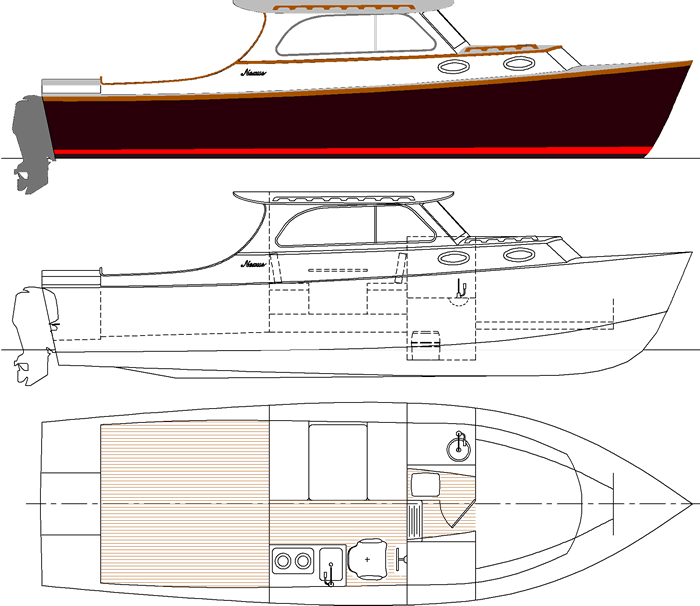


|
 |
||||||||||||||||||||||||||||||||||||||
|
| |||||||||||||||||||||||||||||||||||||||
|
|||
Vashon 31
|
|||
 |
|||
A custom-built, wood, lobster type boat for cruising and family boating. Economical, seaworthy, and stylish.SummaryThe Vashon 31 is designed to take two couples, with perhaps a couple of kids, on cruises that will cover some distance. It's a boat that can be left in the water with no maintenance consequences, other than biennial attention to the anti-fouling paint. The Design Brief Here's one scenario. Let's say you live on Vashon Island. That's a large island in southern Puget Sound, only accessible by ferry. Or say you live anywhere that is at some remove from the cruising grounds you wish to visit. A trailerable boat would be too small. You'll be cruising as part of two couples and you don't want to be crowded. You'll keep the boat nearby, docked or moored in a local bay, because you won't want to drive a long distance or take the island ferry, just to use your boat. How unaesthetic. Let's further specify that you haven't retired yet, and don't have all the time in the world to get to where the fun is, and get back. You've got to do it on the weekend or not at all. The Boat Here, we've drawn a simple, yet well proportioned boat with lines that will look good to boaters for a long time. It's a boat that's designed to be left in the water, and then to be taken on cruises that cover some distance. It's also designed to be affordable. Future expenditures on maintenance and fuel will be low. The Vashon 31 is modeled to cruise at 20 knots. Faster might be nice, but 20 knots is a convenient speed. Any faster, and it requires tremendous attention to avoid objects in the water. Any slower, and a planing boat starts to bog down. Moderate speed, moderate cost A 20 knot cruise will get you to where you are going in a reasonable amount of time. Specifying this speed range allows us to lighten the boat, because impact pressures go down rapidly with speed. "Impact pressures" is boat designer talk for what happens when you get airborne in a chop and the bottom of the boat hits the water. A 20 knot cruise allows much lighter structural weight. Then we can use less power, because a lighter boat is easier to drive. These two things cascade to your benefit. Less power again means less weight for the powerplant and fuel. Going around this cycle a couple of times, we find that we can use a 150 HP 4-stroke outboard to push a 31' boat at planing speeds. This light attainable weight is one of the marvels of modern wood construction. We see the opposite trend in the boating industry today. Today, we see 31' center consoles with three 250 HP outboards. A 4-stroke outboard consumes about one gallon of fuel for every 13 horsepower produced, so that's about 58 gallons per hour at full throttle. One of those puppies would have to make 133 knots to equal the economy of this boat. I think that will be a short-lived trend. This will be a long-lived boat. So why an outboard? A little discussion about outboard power might be in order. We've specified outboard power for this design for many reasons. First, it's light and relatively inexpensive. Fuel costs will be a little higher than with a Diesel, but for most boat owners, fuel costs are not as important as first cost. It takes many, many hours of running per year to financially justify an inboard Diesel installation in a boat of this size. Also, an outboard takes up less hull space than any other powerplant, and it eliminates the worry associated with inboard gas engines. An I/O is out because of my specification that the boat is to be left in the water. Another good thing about an outboard is that the worst that can happen when you hit something in the water is to damage a $250 prop. You can carry a spare, and fixing it won't require a haulout. Yet another good thing is that when you tilt up the outboard, there won't be any underwater metal to cause corrosion problems. Because this design has a hardtop with a bulkhead and door, and an insulated motor cover, there will be little noise heard from the outboard. So, if you're looking for a boat that's fun now, and will still make sense in the future, this could be your boat. |
We are located on the Snohomish River in the Pacific Northwest, about 20 miles north of Seattle.
Click here for a map to Nexus Marine Corporation.
| Home | The Boats | Boat Plans | About Nexus | Why Wood | FAQ | Links |